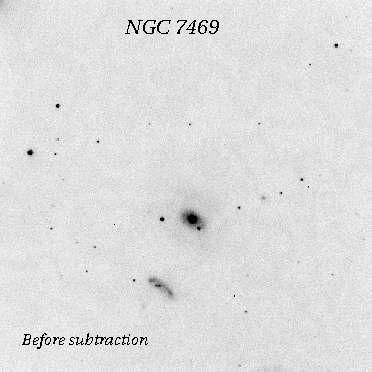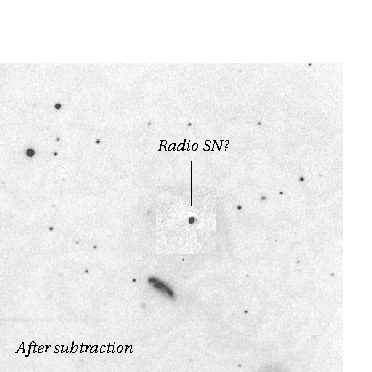



Circular No. 7587
Central Bureau for Astronomical Telegrams INTERNATIONAL ASTRONOMICAL UNION Mailstop 18, Smithsonian Astrophysical Observatory, Cambridge, MA 02138, U.S.A. IAUSUBS@CFA.HARVARD.EDU or FAX 617-495-7231 (subscriptions) BMARSDEN@CFA.HARVARD.EDU or DGREEN@CFA.HARVARD.EDU (science) URL http://cfa-www.harvard.edu/iau/cbat.html Phone 617-495-7244/7440/7444 (for emergency use only)
PROBABLE RADIO SUPERNOVA IN NGC 7469
L. Colina, Instituto de Fisica de Cantabria, Consejo Superior de Investigaciones Cientificas (CSIC); A. Alberdi, Instituto de Astrofisica de Andalucia, CSIC; J. M. Torrelles, Institut d'Estudis Espacials de Catalunya, CSIC; N. Panagia, European Space Agency and Space Telescope Science Institute; and A. S. Wilson, University of Maryland, report the detection of an apparent bright radio supernova on 2000 Oct. 27 with the Very Large Array (VLA) in configuration A: "A 3.6-cm flux density of 1.60 +/- 0.01 mJy/beam is measured at R.A. = 23h00m44s.30, Decl. = +8 36'16".2 (equinox 1950.0). The new radio object is located 1".65 west of the nucleus and within the starburst ring of the bright Seyfert 1 galaxy NGC 7469. Additional data taken with the VLA on 2001 Feb. 13 show that the apparent radio supernova is still bright, with a 3.6-cm flux density similar to that measured on 2000 Oct. 27. The object was not present in radio observations obtained in Sept. 1999 (5-sigma limit of 0.1 mJy). The only known cause of such a luminous radio source is a supernova. Radio monitoring is continuing."
W. D. Li, R. Chornock, and A. V. Filippenko, University of California at Berkeley, report: "NGC 7469 was extensively monitored during the course of LOSS and LOTOSS (cf. IAUC 6627, 7126, 7514). After subtracting a template image observed on 2000 Aug. 9.4 UT, the KAIT images observed from 2000 Aug. 12.3 to Dec 25.1 all showed an apparent 'residual' at R.A. = 23h03m15s.62 +/- 0s.03, Decl. = +8 52'26".5 +/- 0".3 (equinox 2000.0), which is within 0".5 of the optical nucleus of NGC 7469 and is about 2".6 east of the probable radio supernova. Selected unfiltered photometry for the residual object: 2000 Aug. 12.3, 17.8; Sept. 18.2, 17.1; Oct. 1.2, 17.2; 7.2, 16.7; 15.2, 16.3; 19.2, 16.1; 24.2, 14.9; Nov. 12.2, 15.0; 17.2, 15.7; 23.1, 16.4; 28.2, 16.7; Dec. 25.1, 17.4. Though the residual brightened about 3 mag from Aug. 12.3 to Oct. 24.2, the brightness of the nucleus of NGC 7469 changed by only about 0.2 mag (from 13.0 to 12.8). The light curve of the optical residual does not look like any known type of supernova. Because of the apparent offset of the optical residual from the probable radio supernova, and the fact that NGC 7469 is a well-known variable Seyfert galaxy (e.g., Merkulova 2000, A.J. 119, 631), we suspect that the optical residual we detected is caused by the variability of the central AGN, rather than an optical counterpart of the reported radio supernova. Nevertheless, it is interesting to note that the optical residual peaked at about Oct. 24, 3 days before the first detection of the probable radio supernova. Spectra of the nucleus of NGC 7469 were taken with the Lick Shane 3-m telescope on 2000 Nov. 29, Dec. 5, and Dec. 21, and no apparent supernova feature was detected."
Return to KAIT home page